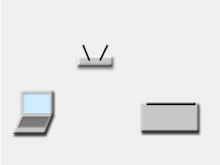Wi-Fi
Wi-Fi is technology for radio wireless local area networking of devices based on the IEEE 802.11 standards. Wi‑Fi is a trademark of the Wi-Fi Alliance, which restricts the use of the term Wi-Fi Certified to products that successfully complete interoperability certification testing.
Devices that can use Wi-Fi technology include desktops and laptops, video game consoles, smartphones and tablets, smart TVs, digital audio players and modern printers. Wi-Fi compatible devices can connect to the Internet via a WLAN and a wireless access point. Such an access point (or hotspot) has a range of about 20 meters (66 feet) indoors and a greater range outdoors. Hotspot coverage can be as small as a single room with walls that block radio waves, or as large as many square kilometres achieved by using multiple overlapping access points.
Wi-Fi most commonly uses the 2.4 gigahertz (12 cm) UHF and 5.8 gigahertz (5 cm) SHF ISM radio bands, these bands are subdivided into multiple channels. Each channel can be time-shared by multiple networks. These wavelengths work best for line-of-sight. Many common materials absorb or reflect them, which further restricts range, but can tend to help minimise interference between different networks in crowded environments. At close range, some versions of Wi-Fi, running on suitable hardware can achieve speeds of over 1 Gbps.
Anyone within range with a wireless network interface controller can attempt to access a network; because of this, Wi-Fi is more vulnerable to attack (called eavesdropping) than wired networks. Wi-Fi Protected Access is a family of technologies created to protect information moving across Wi-Fi networks and includes solutions for personal and enterprise networks. Security features of Wi-Fi Protected Access have included stronger protections and new security practices as the security landscape has changed over time.
History
A 1985 ruling by the U.S. Federal Communications Commission released the ISM band for unlicensed use.These frequency bands are the same ones used by equipment such as microwave ovens and are subject to interference.In 1991, NCR Corporation with AT&T Corporation invented the precursor to 802.11, intended for use in cashier systems, under the name WaveLAN.
The Australian radio-astronomer Dr John O'Sullivan with his colleagues Terence Percival, Graham Daniels, Diet Ostry, and John Deane developed a key patent used in Wi-Fi as a by-product of a Commonwealth Scientific and Industrial Research Organisation (CSIRO) research project, "a failed experiment to detect exploding mini black holes the size of an atomic particle".Dr O'Sullivan and his colleagues are credited with inventing Wi-Fi. In 1992 and 1996, CSIRO obtained patents for a method later used in Wi-Fi to "unsmear" the signal.
The first version of the 802.11 protocol was released in 1997, and provided up to 2 Mbit/s link speeds. This was updated in 1999 with 802.11b to permit 11 Mbit/s link speeds, and this proved to be popular.
In 1999, the Wi-Fi Alliance formed as a trade association to hold the Wi-Fi trademark under which most products are sold.
Wi-Fi uses a large number of patents held by many different organizations.In April 2009, 14 technology companies agreed to pay CSIRO $1 billion for infringements on CSIRO patents. This led to Australia labeling Wi-Fi as an Australian invention, though this has been the subject of some controversy. CSIRO won a further $220 million settlement for Wi-Fi patent-infringements in 2012 with global firms in the United States required to pay the CSIRO licensing rights estimated to be worth an additional $1 billion in royalties.In 2016, the wireless local area network Test Bed was chosen as Australia's contribution to the exhibition A History of the World in 100 Objects held in the National Museum of Australia.
Wi-Fi certification
Specifically, the certification process requires conformance to the IEEE 802.11 radio standards, the WPA2 and WPA3 security standards, and the EAP authentication standard. Certification may optionally include tests of IEEE 802.11 draft standards, interaction with cellular-phone technology in converged devices, and features relating to security set-up, multimedia, and power-saving.Not every Wi-Fi device is submitted for certification. The lack of Wi-Fi certification does not necessarily imply that a device is incompatible with other Wi-Fi devices. The Wi-Fi Alliance may or may not sanction derivative terms, such as Super Wi-Fi, coined by the US Federal Communications Commission (FCC) to describe proposed networking in the UHF TV band in the US.


Comments
Post a Comment